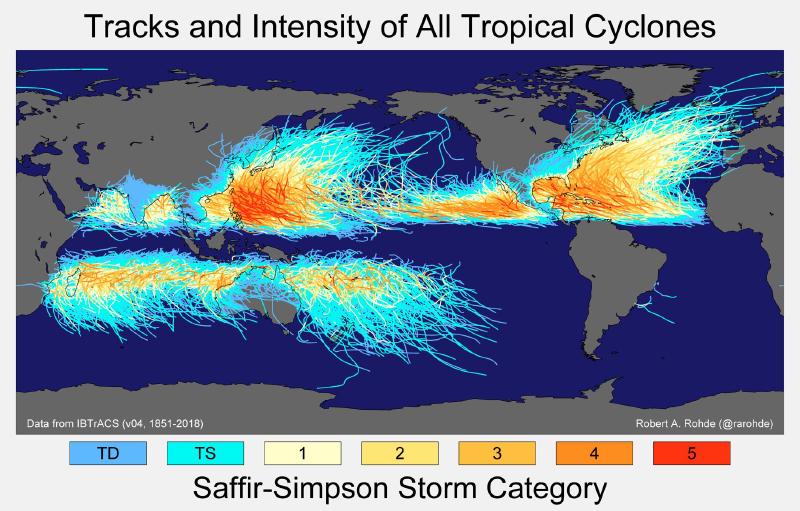Have you ever pondered the mysteries of hurricanes and their behavior? In the realm of meteorology, one claim that often surfaces is the assertion that no hurricane has ever crossed the equator. This intriguing statement raises questions about the nature of these powerful storms and the forces that govern their paths. As we delve into the science behind hurricanes, you’ll discover the fascinating reasons that support this claim, backed by expert insights and historical data.
In the fall of 2024, two hurricanes, Helene and Milton, wreaked havoc across the southeastern United States, sparking discussions and claims online. One particularly viral post on Reddit, which garnered over 103,000 upvotes, boldly stated that no hurricane has crossed the equator. The post even included a map illustrating the tracks of past hurricanes, highlighting a noticeable absence of storms in the southern hemisphere. This claim not only intrigued many but also led to humorous commentary from users, adding a layer of social discourse to the scientific discussion.
As we explore this topic further, we will examine the science behind hurricanes, particularly the influence of the Coriolis effect, an atmospheric force that plays a crucial role in storm formation and movement. Understanding this phenomenon will shed light on why hurricanes remain confined to their respective hemispheres and never cross the equator.
The Science Behind Hurricanes
Hurricanes, also known as tropical cyclones, are powerful storms that form over warm ocean waters, primarily in tropical and subtropical regions. They are categorized based on their wind speeds, with categories ranging from 1 to 5, where category 5 represents the most severe storms. The formation of hurricanes is a complex process influenced by various meteorological factors, including temperature, humidity, and atmospheric pressure.
A key factor in hurricane behavior is the Coriolis effect, which is a result of the Earth's rotation. This effect causes moving air to be deflected, creating a rotation in storm systems. In the Northern Hemisphere, hurricanes rotate counterclockwise, while in the Southern Hemisphere, they rotate clockwise. However, at the equator, the Coriolis effect is virtually nonexistent, which significantly impacts the development of storms.
The Role of the Coriolis Effect
The Coriolis effect is essential for the rotation and movement of hurricanes. Due to the Earth's spherical shape and its rotation, air moving towards the equator does not receive the necessary "spin" to develop into a hurricane. As a result, storms tend to steer away from the equator and remain within the latitude bands of 5 degrees north and south.
Furthermore, the Coriolis effect is strongest near the poles and weakest at the equator. This means that while hurricanes can form and thrive in tropical waters, they are unable to cross the equator. Instead, they are naturally guided by high and low-pressure areas that further reinforce this behavior.
Historical Perspectives and Confirmations
Interestingly, claims regarding hurricanes and the equator are not new. Historical references to this phenomenon date back to at least 2003, with discussions appearing on various platforms, including TikTok and Quora. Recent claims, such as the viral Reddit post in 2023, reignite these discussions, prompting further exploration of the topic.
To solidify the claim that no hurricane has ever crossed the equator, Snopes reached out to the National Weather Service, which confirmed that their records support this assertion. This confirmation, backed by historical data and scientific evidence, reinforces the understanding of hurricane behavior and the effects of environmental factors on storm paths.
Understanding Category Classifications
Hurricanes are classified into categories based on their wind speeds. Category 1 hurricanes have winds of 74-95 mph, while Category 5 hurricanes exceed 157 mph. The color-coded maps representing these categories help visualize the historical paths of storms, with red indicating numerous Category 5 storms and yellow and blue representing weaker storms.
This classification system further emphasizes the distribution of hurricanes and their inability to cross the equator. By understanding the characteristics of these storms and the conditions necessary for their formation, we can appreciate why they remain confined to their respective hemispheres.
Key Takeaways
What You Will Learn
- The Coriolis effect significantly influences hurricane behavior, preventing them from crossing the equator.
- Hurricanes are categorized based on wind speeds, with higher categories indicating more severe storms.
- Historical claims about hurricanes not crossing the equator date back to at least 2003 and are supported by scientific evidence.
- The rotation of the Earth affects storm paths, with high and low-pressure areas guiding hurricanes away from the equator.
Do Solar Farms Really Create Tornadoes? Debunking Misconceptions About Renewable Energy
Fact-Checking Kamala Harris: The Hurricane Relief Plane Controversy
Elon Musk's Weather Manipulation Claims: Fact Or Fiction?


